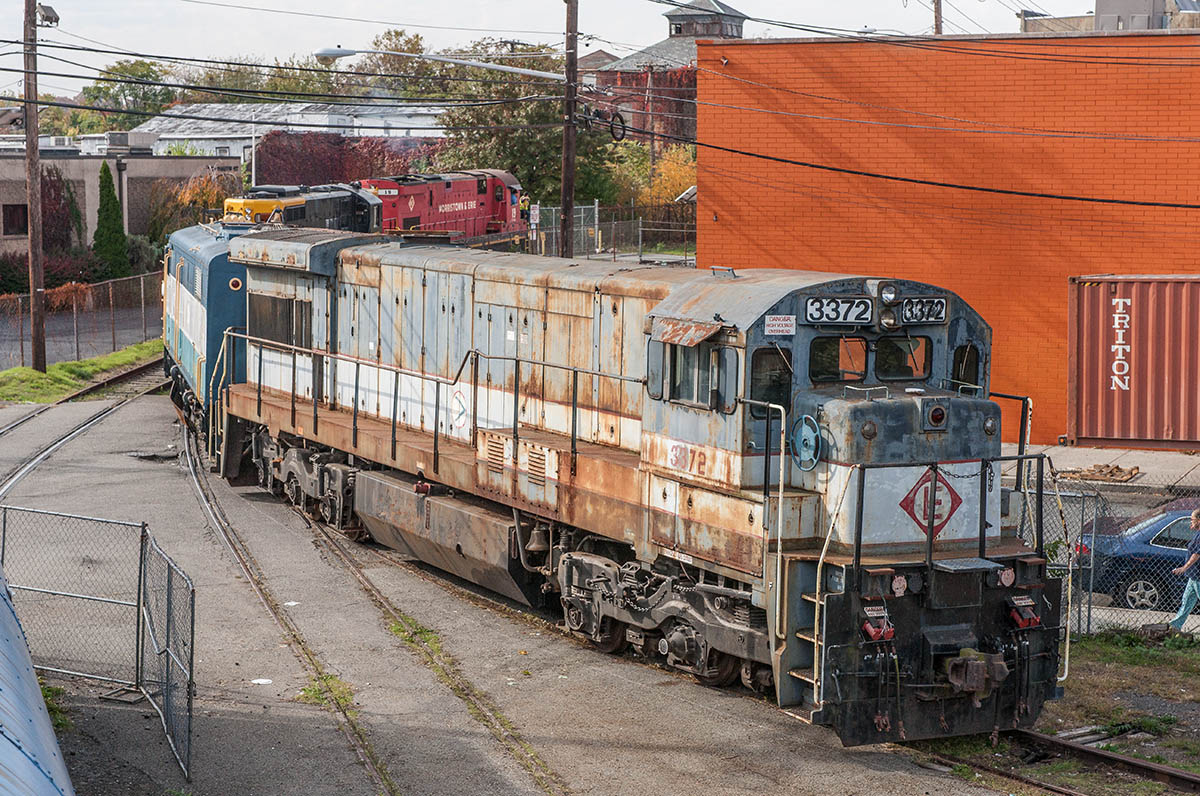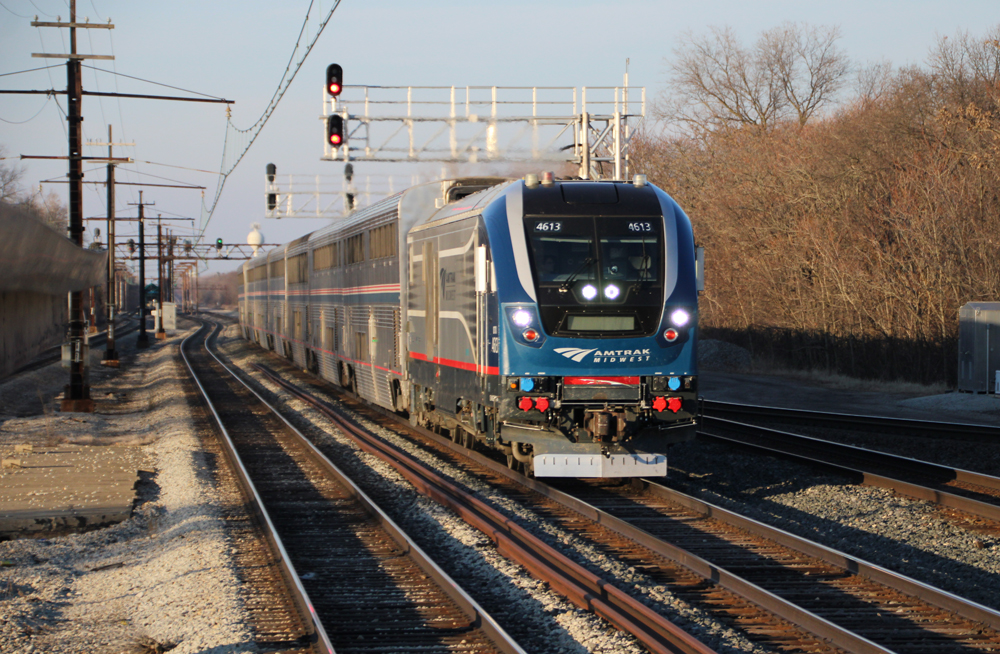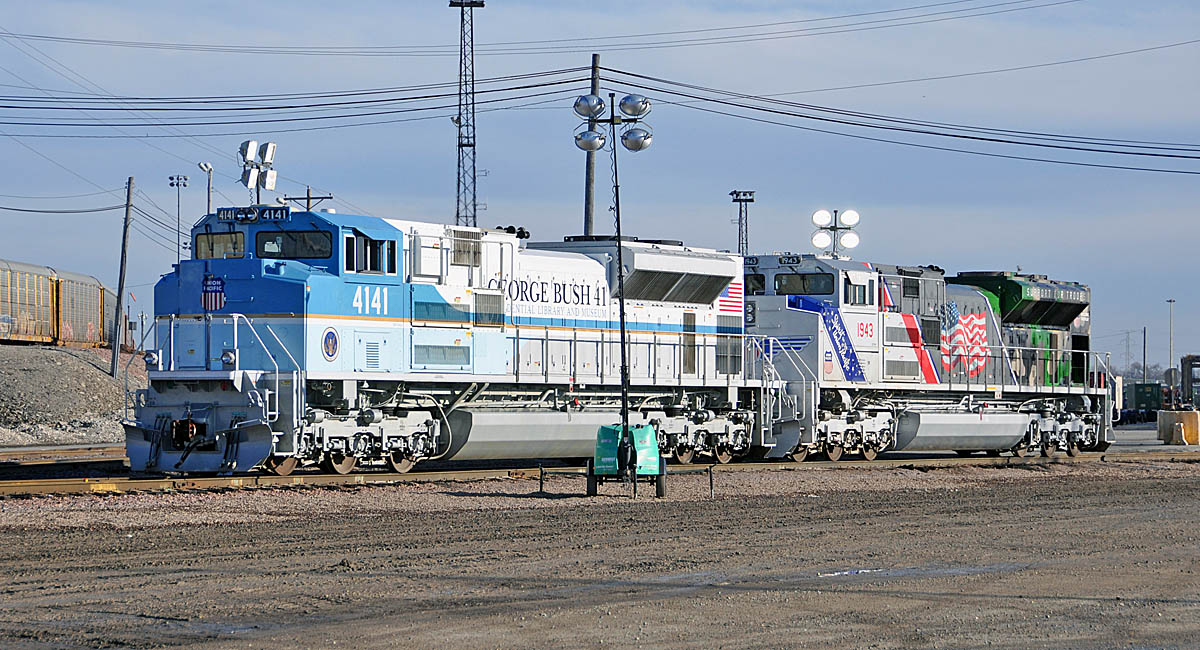URHS President Larry Gross says the locomotive’s move was a big step forward in preserving an engine that played a big part of New Jersey railroading. Thirty-two U34CHs were built for the New Jersey Department of Transportation, later NJ Transit, between 1970 and 1973 for use on the Erie Lackawanna’s commuter lines out of Hoboken. The locomotives were among the earliest GE units built exclusively for passenger service and some of the earliest locomotives to have head-end power, now standard on passenger engines. Because of the U34CH’s head-end power, the engines had a unique and constant roar, even when they were stationary.
The locomotive, which was retired from service in 1994, had been in Passaic since 2000. In 2013, the group established a fund to move the engine. Within six months it had raised the $2,500 to move it and contracted the Morristown & Erie Railway to do the job. This fall, volunteers started clearing the NY&GL’s branch between Passaic and Garfield, which has not been used for five years. On Oct. 29, two M&E Alcos were dispatched to Passaic to bring the big GE home. No. 3372 was moved a mile down the former NY&GL spur before being moved onto NJT trackage for the 60 mile trip to Boonton. According to the URHS, the route was familiar territory for the former U34CHs.
“This move would not have been possible without the cooperation of all four participating railroads: Morristown & Erie, NJ Transit, New York & Greenwood Lake, and Norfolk Southern,” Gross says. “We also have to thank the many supporters who have donated to fund what we have done so far. This restoration project would not be possible without the continuing financial support of the countless U-Boat fans from New Jersey and beyond.”
“We owe a big thank you to everyone who has donated to make this move possible. Now that 3372 is home in Boonton, we can give it a full mechanical evaluation, continue fundraising, and schedule a
plan for operational and cosmetic restoration,” says Steve Gerritsen, vice president of operations for the URHS.
The URHS is now looking to continue raising funds for the project. Donations can be made directly to the “Project U-Boat” via the URHS. Visit www.urhs.org for more information.















Good to see it wearing its original number, instead of 4172 (in the NJT days). I commuted on the EL from 1976 – 1981. Those weren't the best of times for the U Boats then, with a high failure rate. I attributed that to the fact that they were being serviced in E'port, instead of Croxton. (What did CNJ shops know about maintaing GE's)?
Had MANY a cab ride in these units too.
Tom Beckett, Conrail was the primary user of these units in weekend freight service, not EL I think it was the summer of 1976 that saw most of their weekend use (I even lensed the Bi-Centennial on Starruca Viaduct one Sunday morning).
They weren't built exclusively for passenger service, though that's what NJDOT intended. It was fairly common for EL to "borrow" them for a turn to Binghamton or Buffalo over a weekend if they were power short. They performed quite well in freight service, as they were essentially U36C's with HEP generators, and fit well into EL's fleet. They were LOUD though-I can recall on numerous occasions watching them start a train at one of the former EL stations and being astounded by the noise they could make. Good to see one preserved-the U34 was a unique model and a pioneer in providing train hotel power.
To refresh FX Carlin: I can't speak to the Rock Island, but CNJ had GP7P and GP40P locomotives. The GP7P had a squared off section on the bottom of the long hood, and the GP40P had a squared off extended long hood, same as the SDP35/40/45's. In both cases, they housed a steam generator that provided heat for the train. Electric power on those cars was drawn off a belt driven generator, supplemented by a battery when the train was not moving. Some of the GP40P's are still in service, albeit rebuilt for HEP, as there is no longer any steam heated equipment on NJ Transit.
I never thought that one day I'd be waxing nostalgic for U34's—I remember hating them when they first entered service! They were replacing the EL's RS2/3's, GP7's and E8's then being used in commuter service! And that color scheme! But then, I wasn't a commuter having to ride in those ancient Stillwells and Boonton cars. These GE's and the new P-S modern coaches they pulled (and pushed!) were like the wave of the future!
its good to see a rare locomotive saved
U34CH video
https://www.youtube.com/watch?v=7CLxr-RKYOY
Somebody refresh, meaning correct, my recollection that both the Rock and the CNJ carried separate engine- generator sets that sent power back to the train…..though I think it merely kept the batteries charged and did not supply any HVAC functions……and did the first Budd CB&Q and B&M shovel-nosed streamliners have boilers for heating?
this all is referring to "earliest locomotives to have head-end power."
It's nice to see second generation diesels being preserved and restored. The U34CH was a staple on trains running out of Hoboken into the 1990s. URHS has a few low-door Comet 1 cars, so it's entirely possible that they will be able to operate a 1970s-era NJDOT/EL commuter train. Hopefully NJ Transit and Amtrak will allow them to operate excursions on their tracks in the area.
1st-gen EMD's are still running!!
2nd-gen EMD units are still running!